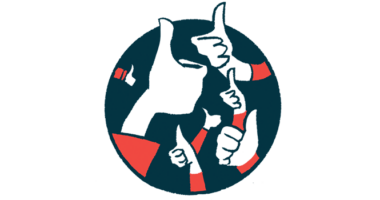Dapirolizumab pegol eases SLE disease activity in Phase 3 trial
One year of treatment also reduced fatigue in participants

One year of treatment with dapirolizumab pegol can reduce fatigue and ease disease activity in people with systemic lupus erythematosus (SLE), according to new results from a Phase 3 clinical trial.
Findings from the trial, called PHOENYCS GO (NCT04294667), were shared by UCB and Biogen, the two companies developing the therapy, at the European Alliance of Associations for Rheumatology’s annual meeting, held this month in Barcelona, Spain.
“An important treatment goal is to improve the quality of life for patients as well as to reduce the long-term risk of organ damage through disease remission,” Eric F. Morand, PhD, head of the Monash Health Rheumatology Unit at Monash University, in Australia, said in a press release from the two companies.
Dapirolizumab pegol shows impact on helping patients achieve remission
SLE is the most common form of lupus, an autoimmune disease wherein the immune system attacks the body’s healthy tissues. It can affect virtually every part of the body, resulting in a range of symptoms.
Dapirolizumab pegol works by blocking CD40L signaling, a molecular pathway involved in the activation of immune cells that drive the autoimmune attack that causes the disease.
The PHOENYCS GO trial tested the therapy in 321 people 16 years and older with moderate to severe SLE disease activity due to persistently active or frequently relapsing disease, despite stable standard of care treatment with antimalarials, glucocorticoids, and/or immunosuppressants.
Participants were randomly assigned to receive dapirolizumab pegol at a dose of 24 mg/kg, or a placebo, in combination with standard of care, once every four months for about one year.
The trial achieved its main goal of reducing disease activity, with significantly more patients given dapirolizumab pegol achieving a response after one year based on the British Isles Lupus Assessment Group-based Composite Lupus Assessment, compared with the placebo (49.5% vs. 34.6%).
Dapirolizumab pegol has shown meaningful impact in helping patients achieve remission and low disease activity, offering the exciting possibility for improved disease control while reducing exposure to glucocorticoids.
In a presentation, titled “Achievement of low disease activity and remission in patients with systemic lupus erythematosus treated with dapirolizumab pegol: 48-week results from a Phase 3 trial,” researchers showed data from an additional analysis showing that significantly more patients on dapirolizumab pegol achieved low disease activity, according to the Lupus Low Disease Activity State (LLDAS), at week 48 (40.9% vs. 19.6%).
A significantly higher proportion of patients receiving the experimental treatment reached disease remission, according to the Definition of Remission in SLE (DORIS) at week 48 (19.2% vs. 8.4%).
Both LLDAS and DORIS include assessments of disease activity in addition to a required low dose of glucocorticoids (below 7.5 mg of prednisone per day in LLDAS, or below 5 mg of prednisone per day in DORIS).
“Dapirolizumab pegol has shown meaningful impact in helping patients achieve remission and low disease activity, offering the exciting possibility for improved disease control while reducing exposure to glucocorticoids,” Morand said.
Treatment group has higher reduction of fatigue
In another presentation, titled “Improvement of fatigue in patients with systemic lupus erythematosus treated with dapirolizumab pegol: 48-week results from a Phase 3 trial,” the researchers presented findings from an analysis focused on assessing the impact of treatment on fatigue.
Results showed people treated with dapirolizumab pegol had a higher reduction of fatigue, as measured by two different tools, compared with a placebo.
Specifically, they had greater improvements in scores on the Functional Assessment of Chronic Illness Therapy-Fatigue test from the study’s start to week 48 (mean change of 8.9 vs. 5.2 points).
“Despite being a common manifestation of systemic lupus erythematosus, fatigue is a difficult-to-treat symptom that can severely impact a person’s quality of life, and remains a challenge to address,” Ioannis Parodis, MD, PhD, associate professor at Karolinska University Hospital, in Sweden, said in the press release. “The results we observed in this Phase 3 study indicate participants treated with dapirolizumab pegol have the potential to achieve consistent improvements in fatigue beyond the current standard of care.”
The treatment’s safety profile was generally favorable. More patients in the treatment group experienced adverse events than those in the placebo group (82.6% vs. 75%), but serious adverse events were more frequent in the placebo group (9.9% vs. 14.8%). Stopping treatment due to adverse events was similar in both groups (4.7% vs. 3.7%).
A second Phase 3 trial, called PHOENYCS FLY (NCT06617325), is currently underway to confirm the results from PHOENYCS GO. This trial is expected to enroll 450 patients with moderate to severe SLE at multiple centers in the U.S., Europe, Asia, and Argentina.
Patients who complete PHOENYCS GO and PHOENYCS FLY may enroll in PHOENYCS GLIDE (NCT04976322), an open-label extension study that will assess the treatment’s long-term safety and efficacy.








